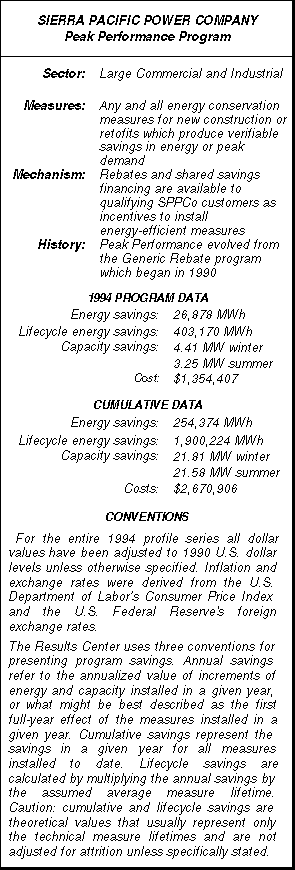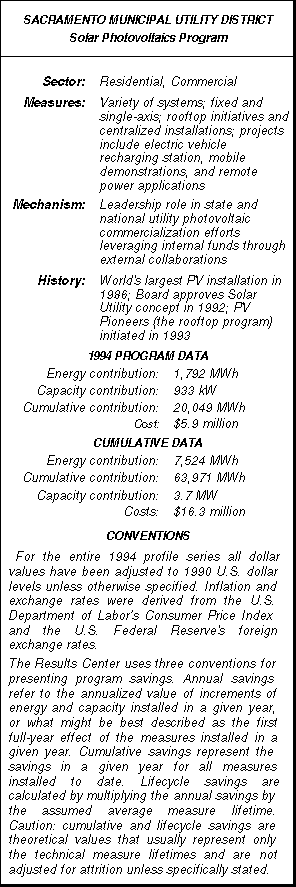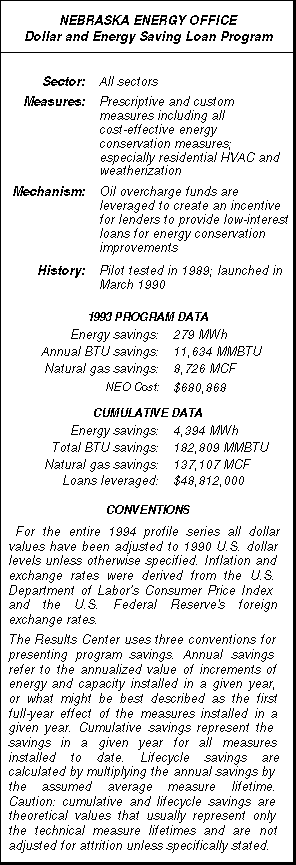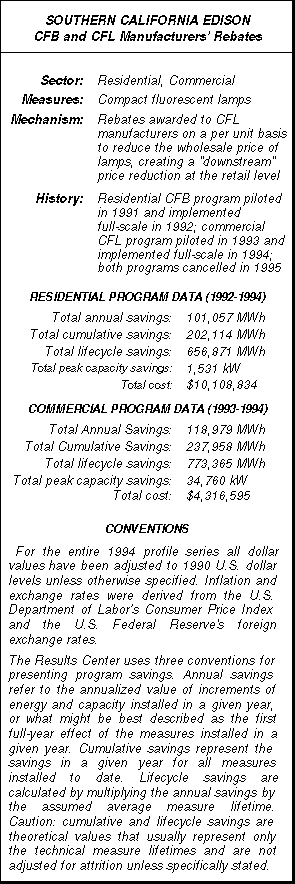EXECUTIVE SUMMARY Sierra Pacific Power Company’s Peak Performance program represents a program that has evolved over time addressing both the needs of the utility and its customers. The program’s roots were typified by conventional incentives. Then in order to make the program more cost effective and to serve a greater number of customers in difficult-to-reach customer segments, the program began to more fully exploit the company’s technical and engineering services while shifting a greater percentage of the resulting retrofits’ costs to customers themselves. Financing was also added as a program option to alleviate participants’ first-cost hurdles and to broaden the net of eligible customers. Now financing and customer capital appears poised to replace rebates as the basis for the program as the utility’s cost effectiveness criteria have become more stringent and electric utility competition increases.
Sierra Pacific Power Company’s Peak Performance program represents a program that has evolved over time addressing both the needs of the utility and its customers. The program’s roots were typified by conventional incentives. Then in order to make the program more cost effective and to serve a greater number of customers in difficult-to-reach customer segments, the program began to more fully exploit the company’s technical and engineering services while shifting a greater percentage of the resulting retrofits’ costs to customers themselves. Financing was also added as a program option to alleviate participants’ first-cost hurdles and to broaden the net of eligible customers. Now financing and customer capital appears poised to replace rebates as the basis for the program as the utility’s cost effectiveness criteria have become more stringent and electric utility competition increases.
Key to the success of the program has been its engineering orientation. The Customer Technical Services Department which implements the program has fashioned the program in line with several other industry trends. Paramount to the program are monitoring and verification of savings. Staff work in close cooperation with a qualified network of engineering firms in the utility’s service territory to identify savings potentials and to perform pre- and post-installation monitoring of customers’ facilities. These trade allies have been critical to the program’s implementation and have been instrumental in assuring that incentives are only paid for validated savings.
Another feature of Peak Performance is its focus on two intriguing customer segments. Since the demand for energy and capacity related to mining is Sierra Pacific’s fastest growing load, Peak Performance works in close cooperation with Mining Customer Services to make this sector’s use of electricity most productive and to serve these customers with enhanced energy services. Incentives have been provided for more efficient equipment, such as motors and pumps, and for process improvements such as gravity-feed water systems.
The gaming industry also presents unique challenges and opportunities for Peak Performance. While casinos and hotels are among the toughest customer segments to address with energy efficiency improvements, through sophisticated technical services Sierra Pacific has been able to make progress with decreasing overall energy consumption while maintaining or improving visitor amenities. Key to this success has been a recognition that these customers' unique needs are generally not financial but instead related to minimizing inconveniences related to energy efficiency while improving the overall productivity of staff and maximizing the gaming floor area and customer comfort. Sierra Pacific experts continue to use their creative and technical abilities to evaluate alternative advanced energy services for casinos -- such as on-site generation and district cooling -- to maximize the efficiency of their power use and to thus retain these customers which are clearly important to both the utility and the area’s economic development.
[CLICK HERE TO DOWNLOAD THE ENTIRE 21 PAGE PROFILE IN PDF FILE FORMAT]
This profile was produced by 

 Sacramento Municipal Utility District (SMUD) is unparalleled in its commitment to renewable energy -- particularly solar -- as well as comprehensive energy efficiency and load management programs. (See Profiles #13,66,83,91) Through its dedication to the development of solar energy as a business strategy, and in collaboration with a number of research and marketing organizations such as UPVG, PV4U, and PVUSA, SMUD has implemented a range of solar technologies to procure resources, to build local expertise and product availability, to educate Sacramento’s citizens, to support peak power generation, and fundamentally to stimulate an important market transformation whereby solar technologies become commercially viable.
Sacramento Municipal Utility District (SMUD) is unparalleled in its commitment to renewable energy -- particularly solar -- as well as comprehensive energy efficiency and load management programs. (See Profiles #13,66,83,91) Through its dedication to the development of solar energy as a business strategy, and in collaboration with a number of research and marketing organizations such as UPVG, PV4U, and PVUSA, SMUD has implemented a range of solar technologies to procure resources, to build local expertise and product availability, to educate Sacramento’s citizens, to support peak power generation, and fundamentally to stimulate an important market transformation whereby solar technologies become commercially viable. The Nebraska Energy Office has implemented the Dollar and Energy Saving Loan program since 1990 with remarkable success, but without much deserved fanfare. Not only has the program resulted in over $52.7 million dollars worth of retrofit activity, 4,394 MWh of annual electricity savings, and 137,107 MCF of natural gas savings, but to do so the Energy Office has effectively leveraged significant private sector funds from the program’s base funding of oil overcharge monies. In an elegant yet simple program design that seems highly transferable, the Energy Office has used the interest income generated from oil overcharge funds to administer the program, while subsidizing low-interest energy efficiency loans by working in close cooperation with commercial lenders in the State.
The Nebraska Energy Office has implemented the Dollar and Energy Saving Loan program since 1990 with remarkable success, but without much deserved fanfare. Not only has the program resulted in over $52.7 million dollars worth of retrofit activity, 4,394 MWh of annual electricity savings, and 137,107 MCF of natural gas savings, but to do so the Energy Office has effectively leveraged significant private sector funds from the program’s base funding of oil overcharge monies. In an elegant yet simple program design that seems highly transferable, the Energy Office has used the interest income generated from oil overcharge funds to administer the program, while subsidizing low-interest energy efficiency loans by working in close cooperation with commercial lenders in the State. Utilities have learned that moving rebates upstream, from the consumer to the vendor, is a cost-effective means of promoting energy efficiency. Southern California Edison has demonstrated the success of this model in its Compact Fluorescent Bulb program, which gives the incentive to the manufacturer, creating two pronounced benefits. First, by requiring that the manufacturer pass along the unit savings downstream, a $5 incentive becomes far greater when it reaches the consumer. (Consumer discounts can reach as high as $15 with a $5 manufacturer’s rebate.) Second, by allocating wholesale rebates to a large quantity of lamps from manufacturers, utilities can stipulate performance criteria, such as maximum levels of harmonic distortion and minimum efficiency levels. Manufacturers’ rebate programs can create financial leverage while transforming the market for energy-efficient products.
Utilities have learned that moving rebates upstream, from the consumer to the vendor, is a cost-effective means of promoting energy efficiency. Southern California Edison has demonstrated the success of this model in its Compact Fluorescent Bulb program, which gives the incentive to the manufacturer, creating two pronounced benefits. First, by requiring that the manufacturer pass along the unit savings downstream, a $5 incentive becomes far greater when it reaches the consumer. (Consumer discounts can reach as high as $15 with a $5 manufacturer’s rebate.) Second, by allocating wholesale rebates to a large quantity of lamps from manufacturers, utilities can stipulate performance criteria, such as maximum levels of harmonic distortion and minimum efficiency levels. Manufacturers’ rebate programs can create financial leverage while transforming the market for energy-efficient products.